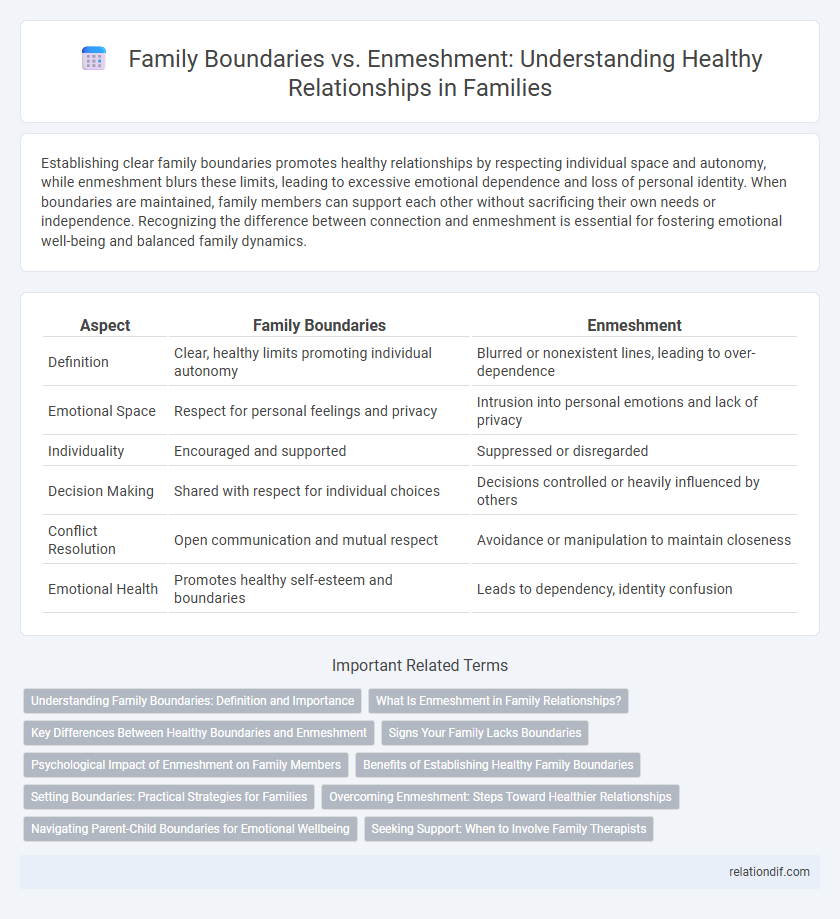Establishing clear family boundaries promotes healthy relationships by respecting individual space and autonomy, while enmeshment blurs these limits, leading to excessive emotional dependence and loss of personal identity. When boundaries are maintained, family members can support each other without sacrificing their own needs or independence. Recognizing the difference between connection and enmeshment is essential for fostering emotional well-being and balanced family dynamics.
Table of Comparison
| Aspect | Family Boundaries | Enmeshment |
|---|---|---|
| Definition | Clear, healthy limits promoting individual autonomy | Blurred or nonexistent lines, leading to over-dependence |
| Emotional Space | Respect for personal feelings and privacy | Intrusion into personal emotions and lack of privacy |
| Individuality | Encouraged and supported | Suppressed or disregarded |
| Decision Making | Shared with respect for individual choices | Decisions controlled or heavily influenced by others |
| Conflict Resolution | Open communication and mutual respect | Avoidance or manipulation to maintain closeness |
| Emotional Health | Promotes healthy self-esteem and boundaries | Leads to dependency, identity confusion |
Understanding Family Boundaries: Definition and Importance
Family boundaries define the emotional and physical limits that protect individual autonomy and promote healthy relationships among members. Clear boundaries prevent enmeshment, which occurs when personal identities become overly blurred, causing dependence and loss of self. Establishing and respecting these limits fosters trust, communication, and emotional well-being within the family unit.
What Is Enmeshment in Family Relationships?
Enmeshment in family relationships occurs when boundaries between family members are overly blurred, leading to a lack of individual autonomy and excessive emotional involvement. This dynamic often results in difficulties establishing personal identity and independent decision-making due to intertwined roles and expectations. Healthy family boundaries promote respect, individuality, and balanced connections, contrasting with the loss of self found in enmeshed relationships.
Key Differences Between Healthy Boundaries and Enmeshment
Healthy family boundaries promote individual autonomy, respect personal space, and encourage open communication, allowing members to maintain their identities while fostering connection. Enmeshment blurs these boundaries, resulting in over-involvement, lack of privacy, and blurred roles, which can hinder emotional development and create dependency. Clear distinctions include the presence of mutual respect in healthy boundaries versus emotional entanglement and control in enmeshed relationships.
Signs Your Family Lacks Boundaries
Signs your family lacks boundaries include a constant invasion of personal privacy, difficulty making independent decisions, and an overwhelming sense of guilt when expressing personal needs. Family members may frequently overstep emotional limits, leading to blurred roles and a loss of individual identity. This enmeshment can cause stress, hinder personal growth, and create challenges in establishing healthy relationships outside the family unit.
Psychological Impact of Enmeshment on Family Members
Enmeshment in family systems often leads to blurred personal boundaries, causing emotional dependency and reduced individual autonomy. Family members may experience increased anxiety, identity confusion, and difficulty establishing healthy relationships outside the family unit. This psychological impact undermines emotional well-being and perpetuates dysfunctional patterns across generations.
Benefits of Establishing Healthy Family Boundaries
Establishing healthy family boundaries promotes individual autonomy and emotional well-being by clearly defining personal limits and responsibilities. These boundaries prevent enmeshment, reducing codependency and enabling family members to develop distinct identities while maintaining supportive relationships. Clear boundaries foster respect, enhance communication, and create a balanced environment where trust and mutual understanding thrive.
Setting Boundaries: Practical Strategies for Families
Setting clear family boundaries helps maintain individual autonomy while fostering healthy relationships, preventing enmeshment where personal identities blur. Practical strategies include defining roles, encouraging open communication, and respecting personal space to promote emotional well-being. Consistent enforcement of these boundaries supports a balanced family dynamic and reduces conflicts.
Overcoming Enmeshment: Steps Toward Healthier Relationships
Establishing clear family boundaries is essential for overcoming enmeshment, which often blurs individual identities and fosters dependency. Practicing open communication, recognizing personal limits, and encouraging autonomy help restore healthy emotional distance within family dynamics. Seeking professional counseling can facilitate this process by providing strategies to rebuild respectful and supportive relationships.
Navigating Parent-Child Boundaries for Emotional Wellbeing
Establishing clear parent-child boundaries is essential for fostering emotional wellbeing and promoting healthy individual development. Effective boundaries encourage respect, autonomy, and open communication, reducing the risk of enmeshment characterized by blurred roles and dependency. Prioritizing consistent limits helps children build self-identity while maintaining strong, supportive family connections.
Seeking Support: When to Involve Family Therapists
Recognizing when family boundaries blur into enmeshment is crucial for seeking support from family therapists who specialize in restoring healthy emotional distances and communication patterns. Involving a family therapist becomes essential when individual identities are compromised, leading to chronic stress or conflict within the family system. Early intervention by a trained therapist can facilitate boundary-setting, promote autonomy, and enhance overall relational dynamics.
family boundaries vs enmeshment Infographic

 relationdif.com
relationdif.com